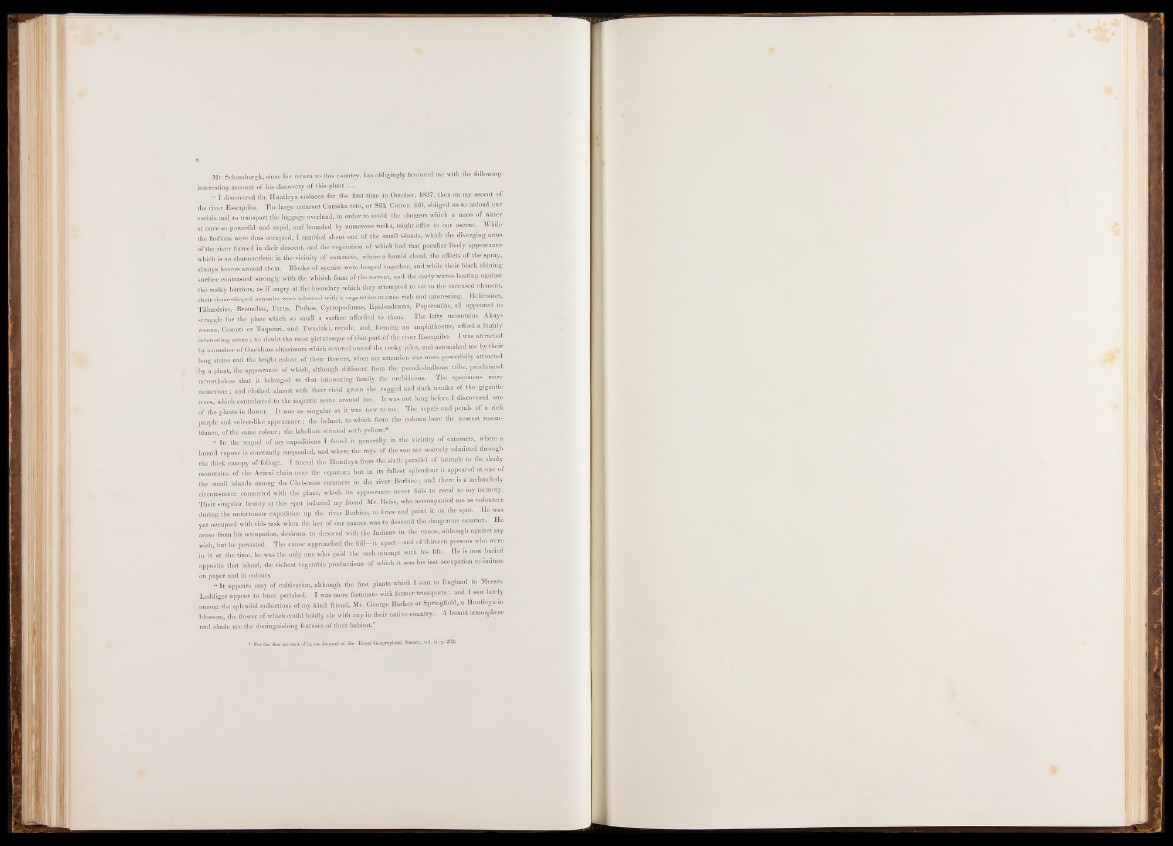
Mr. Schomburgk, since his return to this country, has obligingly favoured me wp ith the foliowi
interesting account of his discovery of this plant
“ X discovered the Hunüeya violacea for the first time in October, 1837, then on my ascent of
the river Essequibo. The large cataract Cumaka toto, or Silk Cotton fall, obliged us to unload our
corials and to transport the luggage overland, in order to avoid the dangers which a mass of water
at once so powerful and rapid, and bounded by numerous rocks, might offer to our ascent. While
the Indians were thus occupied, I rambled about one of the small islands, which the diverging arms
of the inver formed in llicir descent, and the vegetation of which had that peculiar lively appearance
which is so characteristic in the vicinity of cataracts, where a humid cloud, the effects of the spray,
always hovers around them. Blocks of syenite were heaped together, and while their black shining
surface contrasted strongly with the whitish foam of the torrent, and the curly waves beating against
the rocky barriers, as if angry at the boundary which they attempted to set to the incensed element,
their dome-shaped summits were adorned with a vegetation at once rich and interesting. Heliconias,
Tillandsias, Brdmelias, Perns, Pothos, Cyrtopodiums, Epidendrnms, Peperomias, all appeared to
struggle for the place which so small a surface afforded to them. The lofty mountains Akay-
wanna, Comuti or Taquiari, and Twasinki, recede, and, forming an amphitheatre, afford a highly
interesting scène ; no doubt the most picturesque of that part of the river Essequibo. I was attracted
by a number of Oncidium aitissimum which covered one of the rocky piles, tmd astonished me by their
long stems and the bright colour of their flowers, when my attention was more powerfully attracted
,l,y a plant, the appearance of which, although different from the pseudo-bulbous tribe, proclaimed
nevertheless that it belonged , to that interesting family the orchideons. The specimens were
numerous; and clothed almost with their vivid green the rugged-and dark trunks of the gigantic
tuees, which contributed, to the majestic scene around me. It was not long before I discovered one
of the plants in flower. It was as singular as it was new to me. The sepals and petals of a rich
purple and velvet-like appearance ; the helmet, to which form the column bore the nearest resem-
blance, of the same colour ; the labellum striated with yellow.*
« In the sequel' of my expeditions I found it generally in the vicinity of cataracts, where a
humid vapour is constantly suspended, and where the rays of the sun are scarcely admitted through
the thick canopy of foliage. I traced the 'Huntleys from the sixth parallel of latitude to, the shady
mountains of the Acarai chain near the equator; but in its fullest splendour it appeared at one of
the small islands among the Christmas cataracts in the river Berbice; and there is a. melancholy
circumstance connected with the plant, which its appearance never fails to-reeal to my memory.
Their singular beauty at this spot induced my friend Mr. Reiss, who accompanied me as volunteer
during the unfortunate expedition up the river Berbice, to draw and paint it on the spot. He was
yet occupied with this task when the last of our canoes was to descend the dangerous cataract. He
arose from his occupation, desirous to descend with the Indians in the canoe, although against my
wish, but he persisted. The canoe approached the fall—it upset—and of thirteen persons who were
in it at the time, he was the only one who paid the rash attempt with his life. He is now buried
opposite that island, tbe richest vegetable productions of which it was his last occupation to imitato
on paper and in colours.
“ It appears easy of cultivation, although the first plants which I sent to England to Messrs.
Loddiges appear to. have perished. I was more fortunate with, former transports ; and I saw lately
among the splendid collections of my kind friend, Mr. George Barker at Springfield, a Huntleys, m
blossom, the flower of which could boldly vie with any in their native country. A humid atmosphere
and shade are the distinguishing features of their habitat.”
* For the first account of it, see Journal of the Royal Geographical Society, vol. vi. p. 232.